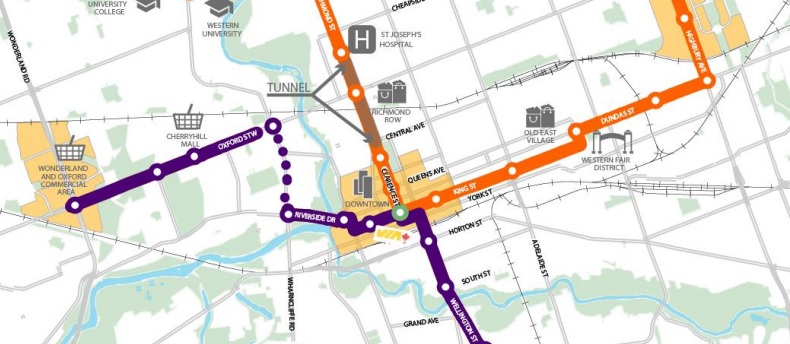Londoners are getting a better idea of what the city’s bus rapid transit plan will look like.

A week after the city held a series of public information sessions, staff recommendations for BRT routes were presented to the rapid transit implementation working group.
Transit officials say riders on the north and east corridors can expect a bus every five minutes while riders on the south and west corridors will see a bus every 10 minutes. Ridership is expected to be heavier along the north and east corridors due to students at Western University and Fanshawe College.
Most of the routes for the $500-million plan will include four lanes of traffic for vehicles in addition to the dedicated bus lanes, however, five kilometres of the 24-kilometre network will have only one lane of traffic both ways for vehicles.
That includes the north corridor along Richmond Street to University Drive. Staff are recommending only two lanes of traffic each way to minimize the impact to trees and property.
Residents in the area have been very outspoken about potentially losing part of their front lawns to the project.
Staff say traffic will be slowed by only 1-1.5 minutes along Richmond during rush hour with minimal impacts outside of rush hour.
Ward 6 Coun. Phil Squire will be holding a ward meeting on March 19 at King’s University College from 7 to 9 p.m. to go into further detail about the potential impacts of BRT on his ward.

Get breaking National news
“When I went to the public participation meetings, there wasn’t that sort of specific focus on my ward — in other words, on Richmond Street, and the university, and what that’s going to look like,” said Squire.
“We also don’t know at this time, what is the university’s position? What is the board of governors’ position on going through campus?”
Squire added that he also learned on Thursday that the bridge over the Thames River to the university will be closed to regular traffic.
“[That] indicates to me that Western will be proceeding with their plan to have a traffic-free campus and that’s really important to my ward too because what that’s going to do is take away your ability if you’re a car operator to drive through the Western campus.”
Rapid transit buses operating on the north and east corridors will travel between Masonville Place in the north and Fanshawe College in the east. The plan calls for expanding the transit terminal at Masonville, which is being done in consultation with Masonville Place as the terminal is on private property.
The plan along the south corridor calls for the Wellington curve to be straightened out. Four lanes of general traffic will be present on Wellington Road from south of the Thames River to Base Line Road, and from Base Line to Bradley Avenue.
The city would like to build a park-and-ride at the end of the south corridor near Exeter Road and Wellington Road but needs to buy land to accomplish that. If it happens, it could serve as a turnaround spot. If it doesn’t, that will happen at an intersection, not at White Oaks Mall.
The west corridor on Oxford Street from Platt’s Lane to Wharncliffe Road will have four general traffic lanes and two centre-running BRT lanes. Rapid transit buses will use Capulet Lane and Capulet Walk for the west turnaround.
The east corridor along Dundas will see Ontario Street, which is currently a one-way street northbound from King Street to Elias Street, turn into a two-way street. BRT lanes on Dundas will also run along the centre of the road. The east turnaround will occur at Fanshawe College.
A draft report on the staff recommendations for BRT routes will be presented to the strategic priorities and policy committee on April 9. City council will vote on the recommendations a day later.
“I very much doubt that there’s going to be a final decision from Western by April 9,” Squire noted.
“People are going to say, ‘What’s it going to cost to go through Western?’ And my answer, I hope will be, ‘Approximately this,’ but if there’s no agreement, I really don’t know what to say about that.”
London city hall is still working to secure full funding for the rapid transit plan. London has committed $130 million while the province agreed to contribute $170 million. The federal government hasn’t yet said when, or if, it will cover the remaining $200 million. There was no mention of specific funding for London’s BRT plan in the recent federal budget.













Comments